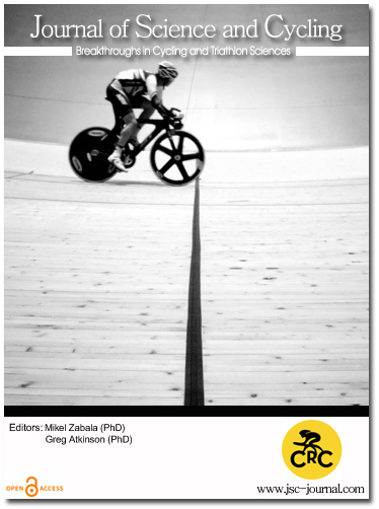A New Approach to Measure Position Stability on the Bike in Time Trial Performance – A Pilot Study
Keywords:
Aerodynamics, Stability, Pressure mapping, Time-Trial, BikefittingAbstract
Introduction: As air resistance is the main source of resistance on flat time trials (Martin 2006, Debraux 2011), aerodynamic analysis and optimization is an important part of the preparation. Besides wind-tunnel testing (Garcia-Lopez 2008), also tests in the velodrome using the Track Aero System (Alphamantis, Montreal, CA) are used. Here the CdA-value is calculated over several laps in real-time. However, this measurement technique does not capture changes in the rider’s position that possibly indicate instability. It is assumed that the athlete’s pelvic stability can be used as indicator for the stability with which a time trial position can be ridden, i.e. the position’s sustainability. Accordingly, this pilot study aims at analysing pelvic stability using a dynamic measure of the location of the centre of pressure (COP). This is an important parameter to quantify the pelvis’ positioning (Kraus 2015). Possible evasive movements on the saddle should be captured and quantified.
Methods: Five professional road cyclists performed the test process on their own time trial bikes in a closed velodrome (Büttgen, GER). Different interventions were performed by changing the settings at the contact point saddle and at the cockpit. In the starting position and after each intervention, the subjects were tested over 10 laps. The parameters speed, cadence and power were measured in real-time using the TAS system. A flexible, saddle-specific pressure mat (GeBioM mbH, Münster, GER) equipped with 64 resistive pressure sensors is fixed to the saddle. The measured data are transmitted with 50Hz to the laptop via a WiFi-transmitter mounted behind the saddle post. The measuring distance is about 200m, accordingly, the entire round could be captured. The analysis parameter COP – capturing the central point of contact on the saddle – was used to measure pelvic stability. It is evaluated referring to the standard deviation of all measurement values of one measurement of the transversal (X) and longitudinal extension (Y) and its position relating to the saddle tip. Additionally, the number of saddle shifts is analysed. A saddle shift is every moment in which the pelvis has no contact to the saddle. We compare and statistically evaluate the measurements with the largest and smallest CdA-value, respectively, using the student’s t-test (p = 0.05) for paired samples.
Results: For all subjects, the number of saddle shifts decreases as the CdA-value becomes smaller. There is a highly significant relation between changing the position and the number of saddle shifts (t = 0.009). The standard deviation of the COP along the longitudinal Y-axis generally decreases over the measurements along with the CdA-value (t=0.058). The standard deviation along the transversal X-axis decreases as the CdA-value decreases for three subjects, while it increases for two subjects (t=0.164). Lastly, as the CdA-value decreases, the COP’s positioning along the longitudinal axis moves towards the saddle tip for three subjects and towards the back for two subjects. None of these moves is significant.
Discussion: The tested combination of two technologies in this pilot study provides first insights concerning the factors of aerodynamics and stability. Changing the position evidently not only affects the CdA-value but also the frequency of saddle shifts in time trials. The COP can be considered as an informative parameter for pelvic stability, as the standard deviation along both axes provide information about the pelvic movement in a given position (fig.1 + 2). A trend emerges according to which a higher stability at the saddle is related to a reduction of the air resistance. The y-coordinate can be used as additional variable to identify the exact positioning of the pelvis on the saddle. In follow-up studies with more subjects the relation between the y-coordinate and the number of saddle shifts should be analysed to address the question of the sustainability of a position. This could also be conducted as a field experiment as all the utilized measurement techniques can be used under real conditions in time trial training on the road.
Downloads
Published
How to Cite
Issue
Section
Copyright (c) 2016 Journal of Science and Cycling

This work is licensed under a Creative Commons Attribution-NonCommercial 4.0 International License.
Authors contributing to Journal of Science and Cycling agree to publish their articles under a Creative Commons CC BY-NC-ND license, allowing third parties to copy and redistribute the material in any medium or format, and to remix, transform, and build upon the material, for any purpose, even commercially, under the condition that appropriate credit is given, that a link to the license is provided, and that you indicate if changes were made. You may do so in any reasonable manner, but not in any way that suggests the licensor endorses you or your use.
Authors retain copyright of their work, with first publication rights granted to Cycling Research Center.






